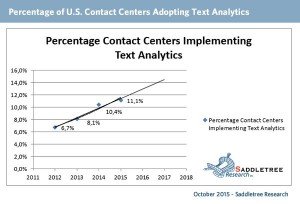Today businesses compete for domination in the digital domain. Customers expect good customer service; many businesses fall short because their digital communications are stranded in the past. It' a safe bet that almost all contact centers in North America provide telephone support. However, there is little doubt about the customer demand for other channels, such as social media and e-mail. These are requirements for the contact center of the future. A generation of digital natives are the driving force behind this change. They have an affinity for digital tools, such as smartphones and tablets, expect to interact from anywhere at any time and expect almost instant feedback and response. Contact centers find themselves in a demanding environment facing constantly changing expectations in managing their consumer-to-business communication.
An underused resource can give you an edge
Text-based communication from customers can provide a wealth of business intelligence similar to unstructured, voice-based communication. Many time this data is ignored, an untapped resource stored in a businesses’ archives. Generally the only time this data is used is during the performance review of an agent or when there is a discrepancy in the service. The use of speech analytics has helped to generate an interest and acceptance of archived voice communications between customers and the business. This led to an interest in using analytics to better understand and create business intelligence from text-based communications. The use of text analytics in the contact center is growing and is anticipated to be a fixture for providing business intelligence.
Mining information by finding patterns, trends and frequency
Text data mining or text analytics is using an automated process to gain intelligence from structured text-based data. This is done by isolating factors such as trends, frequency and patterns of words found in text based digital communication between the customer and the business.
With the objectives of the text analysis in mind, the trends, frequency and patterns are scoured for relevance providing actionable information. Contact centers might aiming to understand the customer experience better or finding concrete relationships between events in order to take action to optimize customer communication. Like most cutting-edge tools, text analytics is most prevalent among the industry’s early adopters. Saddletree Research has been conducting research since 2012 and monitoring the adoption of text analytics at contact centers in the US. In the figure below, you can see the number of US companies using text analytics as a vital part of their strategy to optimize customer experience. The data reflects the time period from the start of 2012 to the start of 2015.
If the adoption trend continues, the use of text analytics will continue to increase beyond 2018. With this acceptance of the technology, text analysis is becoming a mainstay of the customer service industry, instead of being thought of as cutting-edge as it was before. The result of successful text analysis integration, coupled with the rise of the millennials and other digital natives, has placed text analytics in a favorable position to see growth in the years to come.
The reality of omnichannel communication
Saddletree Research found that 93% of US contact centers support customer e-mail queries. They did the research in partnership with the National Association of Call Centers (NACC) and the University of Southern Mississippi. Today, 40% of all contact centers in the US support social media as a channel of customer communication. A further 14 % said that by the end of 2015, they would be adding social media to the channels through which they support customer communication. In the US, 44% of the contact centers additionally support web chat, which adds to the already significant volume of customer communication that reaches the contact center digitally.
1 http://www.saddletreeresearch.com/






